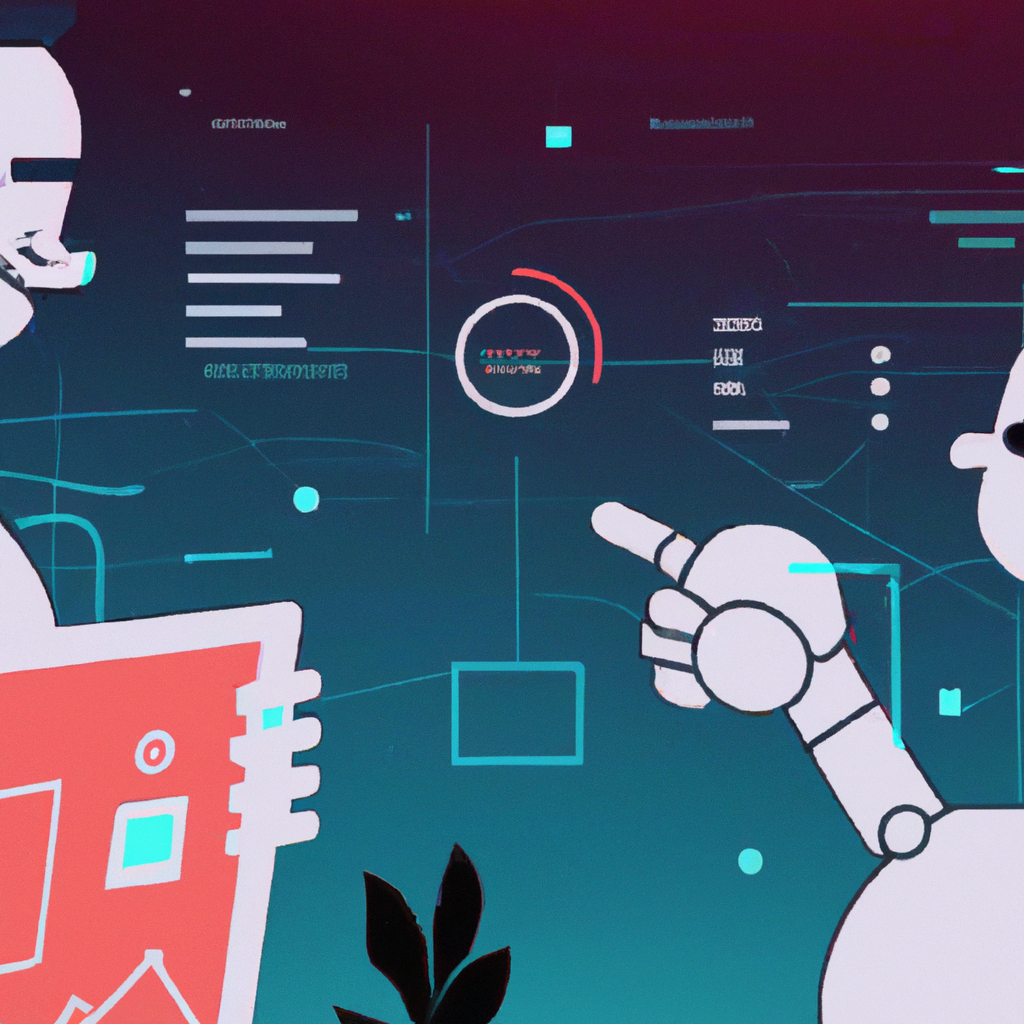AI chatbot builder solutions have become increasingly popular in the business world, offering companies an efficient and automated way to engage with their customers. However, integrating these innovative tools into existing systems is not without its challenges. From ensuring seamless integration with current platforms to addressing potential ethical concerns, businesses must navigate a range of obstacles to successfully implement AI chatbot builder solutions. In this article, we will explore some of the key challenges businesses face and how they can overcome them to unlock the full potential of this technology.

Data Integration Challenges
Lack of compatible data formats
One of the main challenges businesses face when integrating AI chatbot builder solutions is the lack of compatible data formats. Different systems and platforms may use different data structures and formats, making it difficult to seamlessly integrate data from various sources. This can result in data inconsistencies and errors, hindering the accuracy and efficiency of the chatbot’s responses. To address this challenge, businesses need to invest in data standardization processes and develop data integration solutions that can effectively handle different data formats.
Inconsistent data quality
Another data-related challenge businesses encounter when integrating AI chatbot builder solutions is inconsistent data quality. This refers to the presence of inaccurate, outdated, or incomplete information within the integrated data sources. Inconsistent data can lead to inaccurate responses from the chatbot, causing frustration for users and potentially damaging the trust between the business and its customers. To overcome this challenge, businesses need to implement data cleansing and validation techniques to ensure that the integrated data is accurate, reliable, and up-to-date.
Complex data mapping and transformation
The complexity of data mapping and transformation poses a significant challenge in the integration of AI chatbot builder solutions. Data mapping involves identifying the relationships and connections between different data sources, while data transformation involves converting and reformatting data to match the chatbot’s requirements. This process can be complex and time-consuming, especially when dealing with large volumes of data or disparate data sources. To address this challenge, businesses can leverage data integration tools and technologies that simplify the mapping and transformation process, reducing the effort and resources required for integration.
Technology Challenges
Compatibility issues with existing systems
Integrating AI chatbot builder solutions into existing systems can be challenging due to compatibility issues. The chatbot solution needs to seamlessly integrate with various systems and platforms used by the business, such as customer relationship management (CRM) systems, helpdesk software, and e-commerce platforms. Compatibility issues can arise from differences in data formats, integration protocols, or system requirements. To overcome this challenge, businesses should carefully assess the compatibility of the chatbot builder solution with their existing systems and consider implementing middleware or integration adapters to bridge any compatibility gaps.
Scalability and performance limitations
Scalability and performance limitations are common challenges when integrating AI chatbot builder solutions. As the chatbot interacts with more users and handles increasing volumes of data, performance issues may arise, resulting in slow response times or system crashes. Scalability concerns also arise when businesses need to expand their chatbot capabilities to support a growing user base. To address these challenges, businesses should ensure that the chatbot builder solution is designed to handle high volumes of incoming requests, and scalability measures such as load balancing and server clustering should be implemented. Regular performance testing and optimization should also be conducted.
Complexity of AI algorithms
The complexity of AI algorithms used in chatbot builder solutions can pose a challenge for businesses. Developing and maintaining sophisticated AI algorithms requires specialized knowledge and expertise, which may be scarce within the organization. Additionally, the integration of complex AI algorithms into the chatbot builder solution requires careful testing and validation to ensure accurate and reliable responses. To overcome this challenge, businesses can partner with AI specialists or rely on pre-built AI models and frameworks provided by the chatbot builder solution. Regular training and updates should be conducted to keep the AI algorithms up-to-date and aligned with the business objectives.

User Experience Challenges
Lack of natural language understanding
Ensuring a seamless and intuitive user experience is a crucial aspect of AI chatbot integration. However, a common challenge businesses face in this regard is the lack of natural language understanding by the chatbot. Natural language understanding (NLU) encompasses the chatbot’s ability to comprehend and interpret user queries accurately. If the chatbot fails to understand user intent or misinterprets their queries, it can lead to incorrect or irrelevant responses, frustrating the users. To address this challenge, businesses should invest in NLU technologies that can enhance the chatbot’s language comprehension capabilities, including machine learning and natural language processing techniques.
Difficulty in capturing user intent
Capturing and understanding user intent is another user experience challenge in AI chatbot integration. User intent refers to the underlying purpose or goal of a user’s query or interaction with the chatbot. If the chatbot fails to accurately capture user intent, it may provide incorrect or inadequate responses, leading to a suboptimal user experience. To address this challenge, businesses should focus on improving the chatbot’s intent recognition capabilities through machine learning algorithms and training it with diverse and representative user data. Regular analysis and monitoring of user interactions can also help identify and address any gaps in understanding user intent.
Inability to handle complex queries
The inability to handle complex queries can be a significant user experience challenge in AI chatbot integration. Chatbots are often designed to handle specific types of queries or tasks, and when faced with complex or nuanced queries, they may struggle to provide accurate or satisfactory responses. This can result in frustration for users who expect the chatbot to be able to handle a wide range of queries and provide comprehensive support. To overcome this challenge, businesses need to continuously enhance the chatbot’s knowledge base and expand its capabilities to handle a broader range of queries. Leveraging machine learning and advanced analytics techniques can also help the chatbot learn from user interactions and improve its ability to handle complex queries.
Training and Customization Challenges
Insufficient training data
One of the training and customization challenges businesses encounter in AI chatbot integration is the availability of insufficient training data. Training a chatbot to accurately understand and respond to user queries requires ample and diverse training data. However, businesses may struggle to gather enough high-quality training data that is representative of the various scenarios and user interactions the chatbot is expected to handle. Insufficient training data can lead to poor performance and inaccurate responses from the chatbot. To address this challenge, businesses should actively collect and label training data, leverage publicly available datasets, and consider using techniques like data augmentation to enhance the diversity and quality of training data.
Time-consuming customization process
Customizing an AI chatbot to align with a business’s specific requirements and domain can be a time-consuming process. Chatbots need to be trained and customized to understand industry-specific language, handle domain-specific queries, and reflect the business’s brand and tone of voice. This customization process can involve extensive training, testing, and iterative refinement, consuming precious time and resources. To expedite the customization process, businesses can leverage pre-built chatbot templates or frameworks that are designed for specific industries or use cases. These templates can provide a starting point, allowing businesses to customize and fine-tune the chatbot more efficiently.
Continuous monitoring and improvement
Once an AI chatbot is integrated, another challenge businesses face is the continuous monitoring and improvement of its performance. Chatbots need to be regularly monitored to ensure they are providing accurate and relevant responses to users. Additionally, user feedback and interactions should be continuously analyzed to identify areas for improvement and optimize the chatbot’s performance. This involves ongoing training and updating of the chatbot’s AI models, as well as addressing any identified issues or gaps in its capabilities. To overcome this challenge, businesses should establish a feedback loop with users, implement analytics and reporting mechanisms, and have dedicated resources for monitoring and enhancing the chatbot’s performance.

Communication Challenges
Difficulties in maintaining a human-like conversation
One of the key challenges businesses face in integrating AI chatbot builder solutions is maintaining a human-like conversation. While chatbots aim to provide efficient and automated customer support, they must also engage users in a conversational and natural manner. However, achieving a human-like conversation can be challenging, as chatbots may struggle with understanding context, delivering appropriate responses, and utilizing proper tone and language. To address this challenge, businesses need to invest in sophisticated natural language processing (NLP) algorithms and techniques that can enhance the chatbot’s conversational abilities. Regular training and fine-tuning of the chatbot’s language models are crucial to ensure a more human-like conversation.
Handling multiple languages and dialects
In today’s global marketplace, businesses often need to cater to customers who speak different languages or dialects. However, integrating AI chatbot builder solutions that can effectively handle multiple languages and dialects can be challenging. Each language or dialect may have its own unique characteristics, grammar, and vocabulary, making it difficult for chatbots to accurately comprehend and respond to user queries. To address this challenge, businesses should invest in multilingual NLP capabilities and training data that cover a diverse range of languages and dialects. Collaborating with language experts or employing language translation services can also ensure accurate communication across various languages.
Managing user expectations
Managing user expectations is another communication challenge in AI chatbot integration. Users may have varying expectations and assumptions about the capabilities and limitations of chatbots. Some users may expect the chatbot to provide instant and complex support, while others may have lower expectations or skepticism towards AI-powered interactions. Meeting these diverse expectations and ensuring a positive user experience can be challenging. To tackle this challenge, businesses should clearly communicate the chatbot’s capabilities and limitations upfront. Providing accurate and context-specific responses, setting realistic expectations, and proactively seeking feedback from users can help to manage and meet user expectations.
Security and Privacy Challenges
Protection of sensitive customer data
Integrating AI chatbot builder solutions raises concerns about the protection of sensitive customer data. Chatbots often interact with and collect personal and confidential information from users such as names, contact details, or even financial data. Ensuring the security and privacy of this sensitive information is crucial to maintain customer trust and comply with data protection regulations. To address this challenge, businesses should implement robust security measures such as encryption, access controls, and secure data storage. Regular security audits and vulnerability assessments should also be conducted to identify and address any potential weaknesses in the chatbot’s security infrastructure.
Ensuring compliance with data regulations
Data regulations, such as the General Data Protection Regulation (GDPR) in the European Union, impose strict requirements on the collection, storage, and processing of personal data. Integrating AI chatbot builder solutions requires businesses to ensure compliance with these regulations. This includes obtaining proper consent from users, implementing data retention and deletion policies, and providing mechanisms for users to exercise their data rights. To overcome this challenge, businesses should thoroughly assess their legal obligations and consult legal experts to ensure their chatbot integration is compliant with applicable data regulations.
Preventing unauthorized access
Unintended access to chatbot systems and unauthorized use of sensitive data are significant security challenges in AI chatbot integration. Hackers and malicious actors may attempt to exploit vulnerabilities in the chatbot’s infrastructure to gain unauthorized access or extract valuable information. Businesses need to implement robust authentication mechanisms, secure network protocols, and regular security updates to mitigate the risk of unauthorized access. Additionally, employee training and awareness programs can help educate staff about potential security threats and ensure adherence to proper security practices.

Cost and Resource Challenges
High initial investment
Integrating AI chatbot builder solutions can require a significant initial investment. Businesses need to acquire the necessary hardware, software, and AI technology resources to support the chatbot integration. Additionally, there may be costs associated with training, customization, and implementation support. These upfront costs can be a challenge, particularly for small and medium-sized businesses with limited budgets. To overcome this challenge, businesses can explore cloud-based chatbot solutions that offer flexible pricing models or consider partnering with AI service providers that offer cost-effective packages specifically designed for chatbot integration.
Ongoing maintenance and updates
Maintaining and updating an AI chatbot builder solution can be an ongoing cost and resource challenge for businesses. Chatbots require regular monitoring, performance optimization, and software updates to ensure their continued effectiveness and accuracy. This maintenance effort may require dedicated technical resources and ongoing investments in AI expertise. To manage this challenge, businesses should establish an ongoing maintenance plan that includes regular performance assessments, software updates, and continuous improvement initiatives. Leveraging cloud-based chatbot solutions can also offload some maintenance responsibilities to the service provider.
Need for skilled AI professionals
Integrating AI chatbot builder solutions often requires access to skilled AI professionals with specialized knowledge and expertise. Businesses may face challenges in recruiting, hiring, and retaining such professionals, as the demand for AI talent is high and the supply is relatively limited. Without the necessary AI professionals, businesses may struggle with the customization, optimization, and ongoing support of their chatbot solutions. To address this challenge, businesses can consider partnering with AI service providers that offer expertise and support, or invest in training and upskilling existing staff to acquire the necessary AI skills.
Ethical and Legal Challenges
Bias and discrimination in chatbot responses
ethical concerns regarding bias and discrimination can arise in AI chatbot integration. Chatbots learn from training data, and if the training data contains biases or discriminatory patterns, the chatbot may inadvertently exhibit biased or discriminatory behavior in its responses. This can damage the reputation of the business and lead to legal implications. To address this challenge, businesses need to carefully curate and review their training data to eliminate biases and discriminatory patterns. Implementing fairness and bias metrics during the training and testing phases can also help identify and mitigate any potential biases in the chatbot’s responses.
Addressing ethical concerns and responsibilities
Integrating AI chatbot builder solutions brings ethical considerations and responsibilities for businesses. Chatbots have the potential to influence user behavior and make decisions that may impact individuals or society as a whole. Businesses should ensure that their chatbots are developed and deployed ethically, considering factors such as privacy, transparency, and social impact. Establishing ethical guidelines, consulting with experts in AI ethics, and adhering to industry standards and best practices can help businesses navigate and address these ethical challenges.
Regulatory compliance
Integrating AI chatbot builder solutions also requires businesses to comply with various regulations related to data protection, privacy, and consumer rights. These regulations can vary across jurisdictions and industries, adding complexity to the integration process. Businesses must ensure their chatbots adhere to relevant regulations, such as the GDPR in the European Union or the California Consumer Privacy Act (CCPA) in the United States. Compliance measures may include obtaining appropriate user consents, providing clear privacy policies, and implementing mechanisms to honor user data requests. To manage this challenge, businesses should work closely with legal and compliance teams to navigate the regulatory landscape effectively.

Customer Acceptance Challenges
Resistance to AI-powered interactions
Some customers may exhibit resistance or reluctance towards AI-powered interactions, viewing them as impersonal or lacking the human touch. This can pose a challenge for businesses that integrate AI chatbot builder solutions as part of their customer support strategy. Overcoming this resistance requires businesses to educate customers about the benefits and capabilities of AI chatbots, demonstrating how they can provide efficient and accurate support. Offering alternative communication channels, such as live chat or phone support, alongside the chatbot option can also provide customers with a sense of choice and control.
Lack of trust in chatbot capabilities
Building customer trust in chatbot capabilities is another challenge in AI chatbot integration. Customers may be skeptical about the accuracy, reliability, and security of chatbot responses, particularly in complex or sensitive situations. To overcome this challenge, businesses must focus on ensuring the chatbot consistently provides accurate and helpful responses. Regular testing, performance monitoring, and gathering user feedback can help identify and address any trust-related issues. Transparently communicating the limitations of the chatbot and offering human agent fallback options when necessary can also help build trust with customers.
Difficulty in transitioning from traditional customer support
Transitioning customers from traditional customer support channels to AI-powered chatbots can be challenging. Some customers may be accustomed to human agent interactions and may find it difficult to adjust to the self-service nature of chatbots. To tackle this challenge, businesses should provide clear instructions and guidance on how to use the chatbot effectively. Offering personalized assistance during the transition period and capturing feedback from users can help identify pain points and improve the chatbot’s usability. Additionally, businesses can leverage proactive messaging and targeted marketing to encourage customers to try the chatbot and experience its benefits.
Integration and Deployment Challenges
Integration with multiple communication channels
Integrating AI chatbot builder solutions across multiple communication channels can be complex. Chatbots need to seamlessly integrate with various channels, such as websites, mobile apps, social media platforms, and messaging applications. Each channel may have its own communication protocols and requirements, making the integration and synchronization of chatbot responses a challenge. To overcome this challenge, businesses should leverage chatbot platforms or frameworks that provide omni-channel capabilities, allowing for streamlined integration across multiple channels. Standardizing communication protocols and leveraging APIs can also facilitate the integration process.
Ensuring compatibility with various platforms
Integrating AI chatbot builder solutions requires ensuring compatibility with various platforms and technologies. Businesses may use different software frameworks, programming languages, or development environments, which may not be directly compatible with the chatbot builder solution. This can result in compatibility issues and hinder the deployment and integration process. To address this challenge, businesses should assess the compatibility requirements of the chatbot builder solution and their existing infrastructure. Leveraging middleware or integration platforms that support multiple technologies can help bridge the compatibility gaps and facilitate seamless integration.
Seamless deployment across different environments
Deploying and managing chatbots across different environments can present challenges for businesses. Chatbots need to be deployed in development, testing, and production environments, each with its own configuration settings and requirements. Managing the deployment process and ensuring consistency across environments can be complex, particularly when businesses need to update or scale their chatbot deployments. To tackle this challenge, businesses should adopt standardized deployment processes, utilize infrastructure automation tools, and have clear documentation and version control in place. Continuous integration and deployment practices can streamline the deployment across different environments and help reduce errors and inconsistencies.
In conclusion, integrating AI chatbot builder solutions comes with various challenges that businesses need to overcome to ensure successful implementation and utilization. From data integration challenges to user experience, training, and customization challenges, businesses must navigate these obstacles to create effective and efficient chatbot solutions. Additionally, communication challenges, security and privacy concerns, cost and resource considerations, ethical and legal responsibilities, customer acceptance challenges, and integration and deployment complexities further impact the integration process. By proactively addressing and strategizing solutions for these challenges, businesses can leverage AI chatbot builder solutions to enhance customer support, streamline operations, and drive business success.
